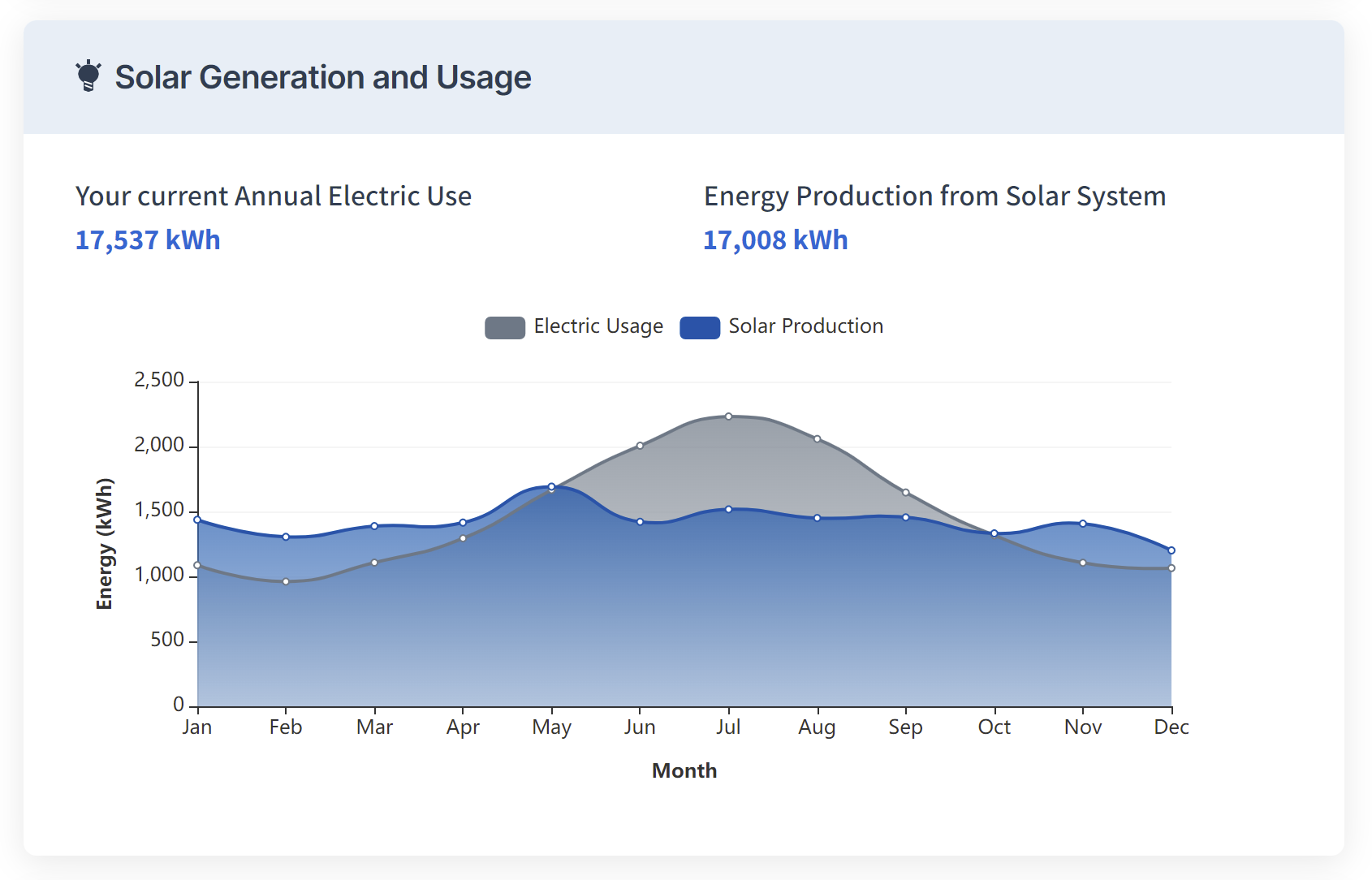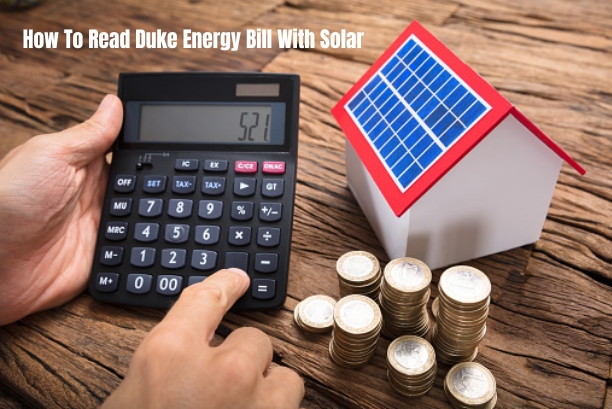To read Duke Energy bill with solar, check the total kilowatt-hours used and any credits from solar production. Look for the net metering summary to see how much energy your solar panels generated and what was credited.
Understanding this information will help you track your energy usage and savings with solar. Transitioning to solar energy is a big step towards sustainability. It not only reduces carbon footprint but also leads to cost savings. When you install solar panels, you become a prosumer, generating and consuming your own energy.
Yet, understanding your Duke Energy bill with solar can be overwhelming at first. Knowing how to interpret the bill is crucial for monitoring your solar production, electricity usage, and potential savings. This guide will help you understand how to read your Duke Energy bill with solar, empowering you to make informed decisions about your energy consumption and savings.

Credit: www.solarreviews.com
Understanding Duke Energy Bill
When it comes to managing your solar energy usage and understanding how it affects your utility bills, it’s important to have a clear understanding of your Duke Energy bill. By familiarizing yourself with the components of a Duke Energy bill and how billing works, you can easily track your solar energy usage and make informed decisions about your energy consumption.
Components Of A Duke Energy Bill
A Duke Energy bill is composed of several key components that provide important information about your energy usage and charges. By understanding these components, you can gain insights into your solar energy consumption and its impact on your utility bills.
Here are the essential components of a Duke Energy bill:
- Account Information: This section provides details about your account number, billing address, and the billing period covered by the statement.
- Service Summary: Here, you’ll find an overview of your energy consumption for the billing period, including the total kilowatt-hour (kWh) usage and the number of days in the billing cycle.
- Rate Information: This section outlines the specific rate or tariff you are on, including any applicable demand charges or time-of-use rates. Understanding your rate structure is important to assess how solar energy impacts your overall costs.
- Energy Charges: The energy charges portion of your bill details the cost per kWh of electricity consumed and provides a breakdown of your solar energy usage versus grid energy consumption.
- Other Charges and Credits: This section includes any additional charges or credits related to services such as metering, equipment rental, or renewable energy programs. It’s important to review these charges to ensure accuracy.
- Total Amount Due: The final section of your bill summarizes the total amount due for the billing period, including any previous balance, payments, and adjustments.
How Billing Works
Understanding how billing works is crucial for effectively managing your solar energy usage and interpreting your Duke Energy bill.
Here’s how the billing process typically works:
- Meter Reading: Duke Energy remotely or manually reads your electric meter to measure the amount of electricity consumed during the billing period.
- Usage Calculation: The recorded meter reading is used to calculate your energy consumption in kilowatt-hours (kWh). This includes both solar energy produced and any additional electricity consumed from the grid.
- Rate Application: Your energy usage is then multiplied by the applicable rate, which incorporates any specific charges or credits based on your rate structure.
- Additional Charges: Any additional charges, such as demand charges or time-of-use rates, are added to the bill based on your rate structure and energy consumption.
- Payment and Adjustment: After applying any payments, credits, or adjustments, the remaining balance is reflected as the total amount due on your Duke Energy bill.

Credit: www.reddit.com
Solar Energy And Duke Energy Bill
When you have solar panels installed on your property, you might wonder how this renewable energy source affects your Duke Energy bill. Understanding the impact of solar energy on your bill and how net metering comes into play can help you optimize your energy consumption and savings.
How Solar Energy Affects Your Bill
Solar energy can significantly reduce your Duke Energy bill by allowing you to generate your own electricity and offsetting the power you would have otherwise purchased from the utility. When your solar panels produce more electricity than you consume, the excess energy is sent back to the grid, earning you credits that can further lower your bill.
Net Metering And Solar Energy
With net metering, your solar energy system is connected to Duke Energy’s grid. Any surplus electricity you generate is fed back into the grid, and you receive credits for the excess power. During periods of low solar generation, such as at night, you can draw electricity from the grid, using the credits you earned earlier. This helps you to effectively store your excess energy and use it when needed, leading to additional savings on your bill.
Tips For Reading Duke Energy Bill With Solar
Understanding your Duke Energy bill with solar can be complicated, but it’s essential for managing your energy consumption. Here are some effective tips to help you unravel the complexities of your Duke Energy bill with solar, enabling you to make informed decisions about your energy usage.
Identify Solar Energy Charges
When reading your Duke Energy bill with solar, focus on identifying the specific charges related to your solar energy system. Look for line items that detail the amount of solar energy you’ve generated and any associated charges or credits.
Review Net Metering Information
Net metering is a crucial component of understanding your Duke Energy bill with solar. It allows you to see how much solar energy you’ve fed back into the grid and how this relates to your overall energy usage. Be sure to review this information carefully to determine any potential cost savings or credits on your bill.

Credit: www.youtube.com
Common Questions About Duke Energy Bill With Solar
Discover how to easily read your Duke Energy bill with solar, including understanding the charges and credits related to your solar energy production. Gain clarity on the common questions surrounding Duke Energy billing for solar customers.
When it comes to understanding your Duke Energy bill with solar, you may have some common questions. In this article, we’ll address two important queries that many homeowners have regarding solar energy. Let’s dive right in!
Can I Save Money With Solar Energy?
Many people wonder if switching to solar energy can help them save money. The answer is a resounding yes! Solar panels can significantly reduce your monthly electricity bills by generating clean, renewable energy from the sun. By harnessing this natural power source, you can decrease your reliance on traditional energy sources, such as coal or natural gas, which often come with rising costs.
Installing solar panels allows you to generate your electricity right on your property. When the sun is shining, your solar panels produce electricity, which can power your home and even charge your solar battery storage system. Any excess electricity that your solar panels generate will flow back into the grid, giving you credits on your Duke Energy bill. These credits offset the cost of the electricity you consume during times when your panels aren’t producing enough energy.
Moreover, some states, including North Carolina, offer additional incentives for solar energy. These incentives may include tax credits, grants, or net metering programs, which further contribute to your savings. By taking advantage of these programs and maximizing your solar energy usage, you can save a substantial amount of money over the long term.
What Happens If I Generate More Electricity Than I Use?
If your solar panels produce more electricity than you consume, you may be wondering what happens with the excess energy. Fortunately, Duke Energy offers a program called net metering, which allows you to receive credits for the surplus electricity you feed back into the grid.
Net metering is a billing arrangement that credits you for the excess electricity your solar panels generate. During times when your solar panels produce more energy than you use, the excess is sent back to Duke Energy’s power grid. This surplus energy is then credited back to you, effectively reducing your future electricity bills.
For example, let’s say your solar panels produce an excess of 100 kilowatt-hours (kWh) in a month. Duke Energy will credit your account for those 100 kWh and subtract them from your future electricity consumption. This means that during periods when your solar panels aren’t generating enough electricity, you can still take advantage of the credits earned through net metering. These credits offset the cost of the electricity you consume from the grid, resulting in potential savings.
Net metering is a great way to ensure you fully utilize the energy generated by your solar panels and maximize your savings. By taking advantage of this program, you can enjoy the benefits of renewable energy while also reducing your reliance on grid electricity.

Frequently Asked Questions On How To Read Duke Energy Bill With Solar
How To Understand A Duke Energy Bill With Solar?
To understand a Duke Energy bill with solar, you need to look for specific information such as net metering credits, solar production, and power consumed from the grid. The bill will provide details on how much electricity your solar panels generate versus how much you use from the utility.
Understanding these metrics is crucial to monitoring your solar energy savings.
Does Duke Energy Offer Net Metering For Solar Customers?
Yes, Duke Energy offers net metering for solar customers. Net metering allows solar customers to earn credits for the excess electricity they generate and send back to the grid. These credits can be used to offset any electricity consumed from the grid when the solar panels are not producing enough power.
How Can I Track My Solar Energy Production On My Duke Energy Bill?
On your Duke Energy bill, you can track your solar energy production through the net metering section. This section will display the total kilowatt-hours (kWh) generated by your solar panels during the billing period. It is important to monitor this information to ensure your solar system is working optimally and to track your savings.
Conclusion
Understanding Duke Energy bills with solar can seem complex at first. However, by breaking it down step-by-step, you can gain a clear understanding of how to read your bill effectively. From understanding the different sections, such as the billing summary and usage details, to identifying the impact of your solar energy usage, this guide has provided you with the necessary knowledge.
With this newfound understanding, you can now navigate your Duke Energy bill confidently and make well-informed decisions about your solar energy usage.

